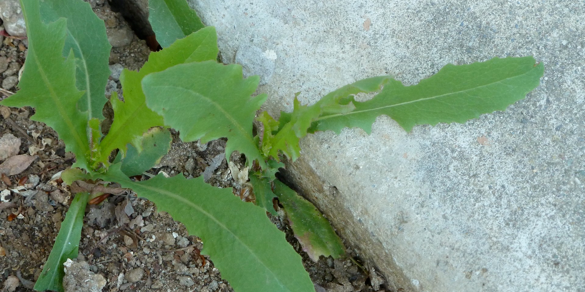
Perky spring dandelions pop up in the most inhospitable environments...
Oh, joyous spring! It’s almost impossible to avoid the famously infectious fever of the season on such glorious days. We’re overcome with purposeful motivation – rejuvenated by the sun’s warm rays and the intoxicating perfume of blossoms in the air. These are days for gardening with gusto, weeding out the blanket of undesirable sprouts, which lay down sturdy roots as fast as we take each breath. Backbreaking work lies ahead if we ignore this green invasion much longer. Family reserves are called upon – grab your gloves and hoes.
Our daughters ask for the specifics of what to pull, knowing mom will often spare ragged looking plants that others would swiftly yank without mercy. I have discovered over years that one person’s weed is another’s treasure. My husband enjoys the tiny coral-tinted blossoms of the scarlet pimpernel while wild radish shoots are a personal favorite – both would be considered troublemakers in other gardens. With half an acre to manage, one learns to value the beauty and even utility of the common weed. Just as we have resigned ourselves to peaceful coexistence with destructive rodent neighbors, in this patch of paradise botanical beauty is in the eyes of the weed-pulling-weary beholder. Eschewing chemicals in the yard leaves no alternative but to open our hearts and minds to hidden possibilities within the plants that grow wild here.
Imagine my delight in learning others share such liberal notions about weeds. Take purslane, also known as pigweed, an annual succulent found in just about every backyard garden. Turns out, this interloper has become a trendy “green” (weed no more) appreciated for its mild, sweet-sour flavor and chewy texture. Google purslane, and you’re likely to find loads of appetizing recipes. If you’ve been pulling this fast spreading plant and tossing in the yard waste – well, think again.
Of course there’s dandelion – the perennial childhood favorite. Who could forget flower chains strung together on a spring day? Here in the adult world, as we struggle in a tug of war with the weed’s mighty taproot, is occasion for channeling the tenderhearted child within. Dandelion may top our list of so-called weeds, but what really defines a weed anyway? On a quest for the pristine lawn, we’ve missed a plant that offers rustic beauty as well as edible bounty, without asking for the least effort on our part in return.
Turns out, this perky weed is a nutritional gold mine. Dandelion greens are utterly loaded with Vitamins A and K (topping 100% and 500% of our daily requirement, respectively), and an excellent source of Vitamin C, calcium and iron. There’s even beneficial amounts of Vitamin E, B6, riboflavin, thiamin, manganese and potassium.
Dandelion delights fans with its earthy sharpness –reminiscent of radicchio, endive and escarole. To the novice consumer, the flavor might seem overly bitter. Here in the U.S. we surround ourselves with sweetness, so our taste buds are sometimes uneducated about the virtues of bitter flavor. To take full advantage of dandelions’ vibrant edge, try pairing it with equally assertive ingredients such as goat cheese, lemon, vinegar, pancetta or bacon and aromatics such as garlic, onion and leek. Another approach is to use the greens as an accent to smoother flavors such as cream and potatoes or mix with milder leaves to balance the tang. Some cooks soften dandelions’ sharpness by blanching leaves for a few minutes, then removing from the water and using as called for in recipes.
Cultivated dandelion greens are native to Eurasia, where this plant is appreciated for its medicinal properties as well as its culinary versatility. Dandelion boasts a variety of therapeutic uses – for instance as a diuretic, liver cleanser and digestive aide. In the kitchen, try baking in a frittata, gratin or tart, adding to soups, sautés and pasta dishes. Simple to prepare, just remove the tough lower stem from the tender leaves and rinse thoroughly to remove any gritty residue.
Learn to coexist with this much-maligned scourge of the American lawn. You’ll be rewarded with delightful yellow flowers and tasty, powerhouse nutrition.
Recipe – Dandelion Greens and Goat Cheese Gratin

